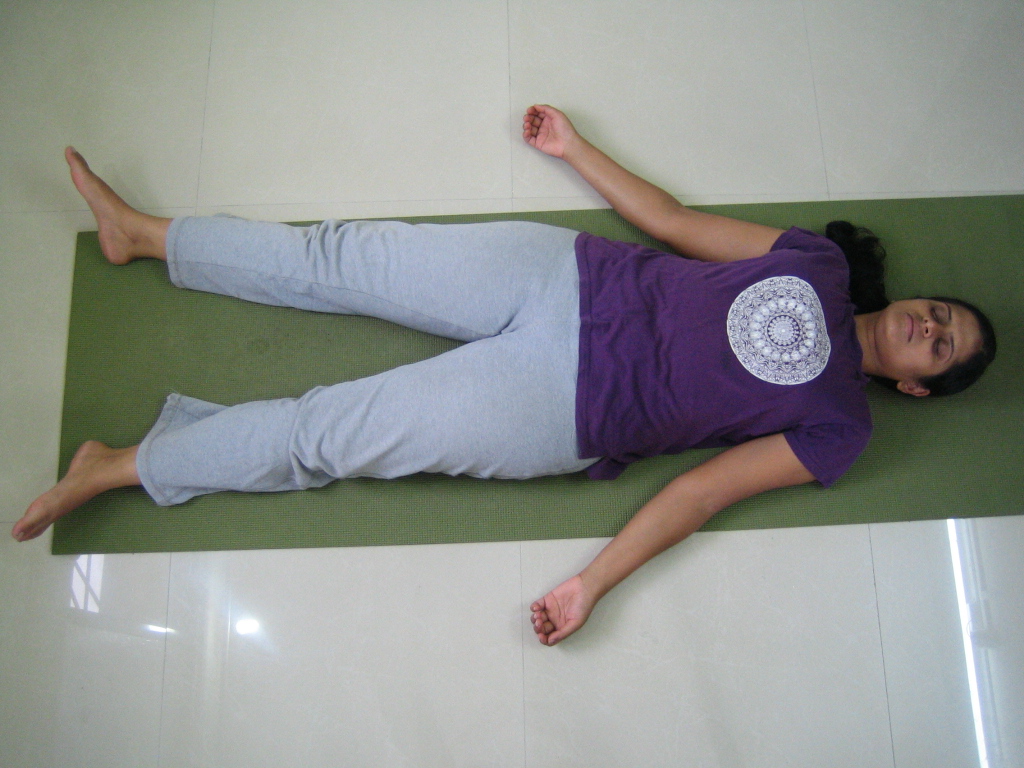
Meaning :
Shav is corpse; asana is posture.
The name reflects the posture of a dead body.
Benefits of Shavasana
1. This practice is for complete physical and mental relaxation.
2. It brings great psycho-physiological coordination.
3. Releases stiffness and fatigue, enhancing relaxation of the body.
4. Helps reduce stress, anxiety, depression, confusion, insomnia, dementia, etc.
5. Improves breathing and awareness, both internally and externally.
6. Good for all disorders related to stress like hypertension, heart problems, diabetes.
7. As the mind relaxes, mental focus, efficiency and creativity improves.
8. As there is physical relaxation, one finds energy, enthusiasm and acceptance for challenges.
The Posture
1. Lie flat on the back, keeping hands 6 inches away from body, palms facing upward and fingers gently half-folded, legs separated at a comfortable distance, may be one foot or one and half feet. Keep a little distance between the teeth, lips closed and eyes closed. This is the physical preparation for the posture. Once you have acquired the posture, do not make any physical movement or open the eyes since this will disturb the practice.
2. Start becoming aware of your whole body, spend a minute perceiving your whole body and posture.
3. As you lie in the posture with your eyes closed, listen to surrounding sounds, get the feel of your skin, become mentally aware of the place in which you are lying down.
4. Now shift your awareness towards your right hand, then the right side of body and then the whole right leg.
5. Shift your awareness towards your left hand, then the left side of body, then the whole left leg.
6. Shift your awareness to your whole back - from both the heels till the the back of the head.
7. Shift your awareness to your whole front - from the forehead to the toes.
8. Now try to be aware of the whole body as one.
9. Become conscious of your breathing - as your awareness shifts to your breathing, do not change the speed. Observe the natural flow of your breath. Find the rhythm in the breath going in and the breath going out.
10. Be in the posture and remain aware for some time. As you relax, become conscious of your body and surroundings. Make gentle movements with your fingers and toes, slowly turn to your right side, and and sit up.
Note
Shavasana is generally done at the end of the practice of Yogasanas or after hard mental or physical work or when you feel the need for relaxation. Avoid this practice immediately after meals.
This practice can be done for long or short stretches of time according to time availability and your requirement. While doing the longer practice, make sure that you do not fall asleep and while doing the short practice, do it efficiently.
Step1
Contemplation
Take the following points into consideration during the practice of this asana:
1. Aim for pure awareness toward your body, breath and mind.
2. In this process you are a seer and not a doer, thus you have to observe / witness everything without judgment.
3. This posture is a great tool towards self understanding and creating harmony between your body and mind. Thus be conscious and observant.
- Contributed by Divyayog www.divyayog.in
Yoga practice is a physical activity; kindly consult your physician before you take it up. You are solely responsible for your health while performing the practice.







